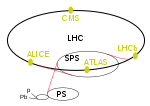Portal:Science/Featured article/15
ATLAS (A Toroidal LHC ApparatuS) is one of the five particle detector experiments (ALICE, ATLAS, CMS, TOTEM, and LHCb) being constructed at the Large Hadron Collider, a new particle accelerator at CERN in Switzerland. It will be 45 metres long and 25 metres in diameter, and will weigh about 7,000 tonnes. The project involves roughly 2,000 scientists and engineers at 151 institutions in 34 countries. The construction was completed in 2008. The experiment is expected to measure phenomena that involve highly massive particles which were not measurable using earlier lower-energy accelerators and might shed light on new theories of particle physics beyond the Standard Model.
The ATLAS collaboration, the group of physicists building the detector, was formed in 1992 when the proposed EAGLE (Experiment for Accurate Gamma, Lepton and Energy Measurements) and ASCOT (Apparatus with Super COnducting Toroids) collaborations merged their efforts into building a single, general-purpose particle detector for the Large Hadron Collider. The design was a combination of those two previous designs, as well as the detector research and development that had been done for the Superconducting Supercollider.

